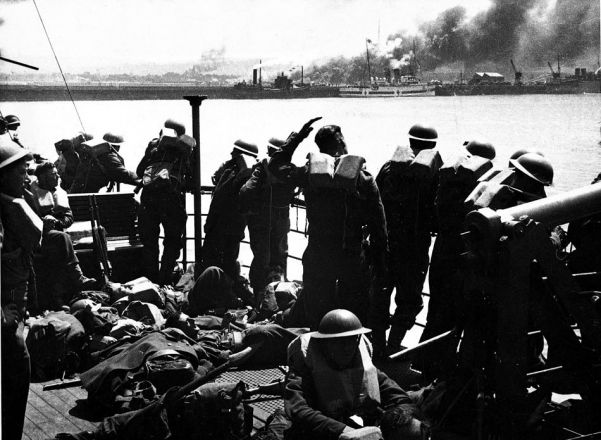7-10 May
Politics, Britain
Prime Minister Neville Chamberlain is severely criticized over the Norwegian campaign during a House of Commons debate. Chamberlain resigns after a significant fall in government support in a vote of confidence and the opposition Labour Party’s refusal to serve under him in a coalition. Winston Churchill replaces him and forms a coalition government.
8 May
Politics, Soviet Union
General Semyon Timoshenko replaces Marshal Kliment Voroshilov as the Soviet commissar for defense.
10 May
Western Front, Luxembourg/Holland/Belgium
The Germany’s Army Group A, under General Gerd von Rundstedt, and Group B, commanded by General Fedor von Bock, invade after preliminary air attacks. Successful airborne landings are made against Belgium’s key Frontier fortress of Eben Emael, and in Holland, to dislocate resistance. General Ritter von Leeb’s Army Group C covers France’s Maginot Line, the line of subterranean forts and other defensive positions running along its border with Germany.
In accordance with Allied planning, the left flank of the British and French line moves into Belgium. This decision facilitates Rundstedt’s surprise Ardennes advance, which eventually divides the Allied armies in Belgium from those in France. The Allied armies advancing into Belgium up to the Dyle and Meuse Rivers above Namur, a position known as the Dyle Plan Line, are hampered by poor coordination with Dutch and Belgian forces.
11-15 May
Western Front, Holland/Belgium
Dutch resistance to the German attack crumbles, despite opening the flood gates and mining the Rhine River to obstruct the enemy. German forces begin to approach the Allied Dyle Line, while Belgian defenders are driven back from the Albert Canal.
Queen Wilhelmina of the Netherlands escapes with the Dutch government to Britain on May 13. The city of Rotterdam is bombed before a cease-fire is declared on the 14th, and the Dutch Army capitulates the next day.
12-14 May
Western Front, France
German forces reach the Meuse River, the crossing of which is critical for the advance into France. Dive-bombers pound French positions and inflatable rafts are used to establish bridgeheads at Sedan and Dinant on the 13th. Despite Allied air attacks, German armor advances westward rapidly, opening a 50-mile (75-km) gap in the Allied line. This drives a wedge between the French Ninth and Second Armies, which then mount a futile response.
15-20 May
Western Front, Belgium
Germany’s Sixth and Eighteenth Armies force the Allies to withdraw from the Dyle Plan Line to the Scheldt Line, west of Brussels, and the Dendre River. French forces have been forced to fall back from Holland, while the Belgians continue fighting between Antwerp and Brussels, finally retreating to the Escaut Canal and then to the Lys River, which is reached on the 20th.
15 May
Air War, Germany
Britain launches its first strategic air attack on Germany with 99 aircraft hitting oil plants and railroad marshaling yards in the Ruhr region.
16-20 May
Western Front, France
The French General Reserve and units south of the German forces are ordered to form the Sixth Army to bolster the vulnerable Allied lines, but this fails to halt the German advance. Brigadier General Charles de Gaulle’s 4th Armored Division attempts to counterattack around Laon-Montcornet on May 17-19 but fails.
German tanks reach Cambrai on May 18, and finally the sea at Abbeville two days later. It now becomes critical for the Allies to cut the ‘corridor’ made by the panzers or risk the isolation of their armies to the north from the forces in the south. The dismissal of General Maurice Gamelin, the Allied commander-in-chief, and the appointment of Maxime Weygand as his successor on the 19th further delays military decision-making, which reduces the potential for any action.
21-28 May
Western Front, France
British tanks battle with the 7th Panzer Division at Arras until May 23. General Heinz Guderian moves toward Boulogne and Calais unaffected by the Allied ‘Weygand Plan,’ which attempts to split the tank spearhead from troops and supplies in the German ‘corridor.’ Boulogne and Calais capitulate after the naval evacuation of Allied troops.
Eager to preserve his panzers for taking Paris, Hitler halts General Gerd von Rundstedt’s armor at Gravelines and allows the air force to attack the Allied ‘pocket’ centering on Dunkirk. British aircraft, however, resist the attacks, enabling the Allies to prepare for an evacuation.
25-28 May
Western Front, Belgium
King Leopold of Belgium’s forces are left surrounded as the Allies withdraw to Dunkirk. Resistance seems futile and he decides to surrender on the 28th. Belgium has lost 7550 men killed. The surrender leaves the left flank of the Allied line increasingly vulnerable, and there is no hope of holding out in Belgium. The exiled Belgium government in Paris condemns King Leopold’s surrender and assumes his powers.
26 May
Western Front,France/Belgium

Operation Dynamo, the evacuation of Allied forces from the Dunkirk area, begins. A defensive perimeter established on the Aa, Scarpe, and Yser ‘canal line’ covers the withdrawal, while an assorted rescue flotilla of pleasure boats, commercial craft, and naval vessels crosses and recrosses the English Channel.
31 May
Politics, United States
President Franklin D. Roosevelt launches a ‘billion-dollar defense program’ to bolster the armed forces.
